

Using video effectively in your lessons. Film clips can prove a powerful pupil engagement tool for teachers, but what are the golden rules for using video in lessons?
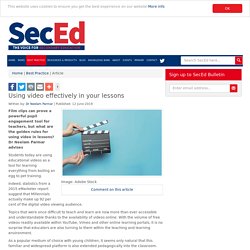
Dr Neelam Parmar advises Students today are using educational videos as a tool for learning everything from boiling an egg to pet training. Indeed, statistics from a 2015 eMarketer report suggest that Millennials actually make up 92 per cent of the digital video viewing audience. Topics that were once difficult to teach and learn are now more than ever accessible and understandable thanks to the availability of videos online. With the volume of free videos readily available within YouTube, Vimeo and other online learning portals, it is no surprise that educators are also turning to them within the teaching and learning environment. As a popular medium of choice with young children, it seems only natural that this familiar and widespread platform is also extended pedagogically into the classroom. When using video, you may wish to consider the following ideas: Pearson Efficacy Reporting Framework 20 March 2019.
2018 wgs5 networks learning en. Teachers: your guide to learning strategies that really work. Research on effective learning reveals that an awful lot of what goes on in the classroom simply doesn’t matter.
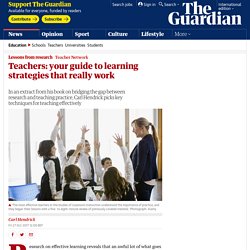
There are many pointless activities that take up valuable time in the name of engagement, merely demonstrating progress as opposed to actually making progress. Assessing the evidence for edtech. The widespread criticisms of the recent LSE and OECD reports are poorly founded and do nothing but undermine the argument for serious edtech Those of us who complain that edtech gets too little attention in the national press should perhaps have been beware of what we wished for.

Two recent studies to have hit the headlines both say that the general impact of technology on learning is negative. Full potential of digital technologies for FE yet to be realised, surveys find - The Education and Training Foundation. Posted on June 14th, 2019 The use of technology in teaching and learning in Further Education is widespread, but its full potential is yet to be realised.

That’s according to two reports, The 2019 Teacher Digital Perspectives Survey and The 2019 Learner Digital Perspectives Survey, published today (14 June 2019) by the Education and Training Foundation (ETF). Instructional Video Starter Doc AND Storyboard. Instructional Video Planning, Producing, & Evaluating Hurlbert Manning. Action plan blend it and share it learning working group. DfE Education Technology Strategy. Topic 3: Learning in communities – networked & collaborative learning. 30 October – 12 NovemberIs 1+1=2 or is there more to it?

The coming two weeks will be all about learning in communities, networking and collaboration. Most of us have experiences from group work, that for some reason hasn’t worked all that well. It may have turned out as cooperative rather than collaborative or there may have been social loafing involved. So – when it really works well, how does this change the way we learn? 10 Reasons Today’s Students NEED Technology in the Classroom. Technology is everywhere--entwined in almost every part of our culture.
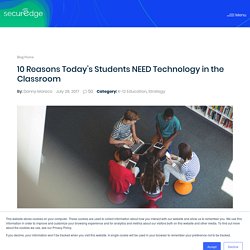
It affects how we live, work, play, and most importantly learn. With mobile and other wireless devices like the IoT becoming an increasing requirement across every industry today, it only makes sense that our schools are also effectively deploying mobile technology in the classroom. However, for many schools, implementing the latest technology is a difficult strategy to navigate. There are two main reasons for this: Schools are on the fence about the use of certain mobile devices; thinking they're more a burden than a strategic learning tool. Schools want to deploy mobile devices but their WiFi networks are not capable of properly supporting the technology In both cases it's a lose lose situation for everyone involved, especially the students. Beyond the Institution: Networked Professionals & Digital Engagement … Jisc at ALT Annual Conference (altc) 2016.
Cathy Moore - Action mapping — throw them in at the deep end - LT16 Conference. Action mapping: A visual approach to training design. Action mapping is a streamlined process to design training in the business world.

Its goal is to help designers: Commit to measurably improving the performance of the businessIdentify the best solution to the performance problemWhen training is necessary, create challenging simulations, not information presentations I created the process in May 2008, when I was designing custom elearning for corporate clients (here’s the first blog post about it). The following slideshow gives a simplified, very high-level overview. It uses lighthearted stock photos from 2008 of a guy dressed in a ninja outfit. Because I was designing elearning at the time, I presented action mapping as an elearning design model, but it works for all types of business training, as I show in my workshops.
The addition of a flowchart In May 2013, I deepened step 2 to include the use of a flowchart that helps identify lean, in-the-workflow solutions, such as job aids or process improvements. Hybrid Pedagogy. Blended learning: Problems and Prospects at the Higher Level. Blended Learning at Otis: Best Practices. Gaining Support for Blended Learning. In November, I was fortunate to have the opportunity to visit several schools that are personalizing learning for students through blended learning models.
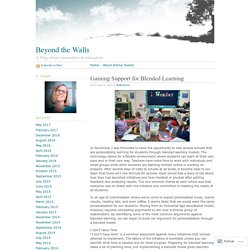
The technology allows for a flexible environment where students can learn at their own pace and in their own way. Teachers have more time to work with individuals and small groups while other students are learning content online or working on projects. After several days of visits to schools at all levels, it become clear to our team that there isn’t one formula for success. Each school had a story to tell about how they had launched initiatives and then iterated or pivoted after getting feedback and analyzing results. The one common theme at each school was that everyone was on board with the initiative and committed to meeting the needs of all students. Action mapping: A visual approach to training design. Seven musts for creating effective eLearning. International Journal of Educational Technology in Higher Education. A Visual Primer On Learning Theory.
Theories on how people learn are not new.
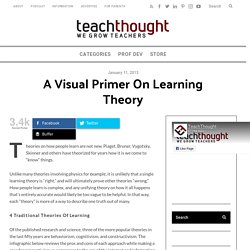
Piaget, Bruner, Vygotsky, Skinner and others have theorized for years how it is we come to “know” things. Unlike many theories involving physics for example, it is unlikely that a single learning theory is “right,” and will ultimately prove other theories “wrong.” How people learn is complex, and any unifying theory on how it all happens that’s entirely accurate would likely be too vague to be helpful. In that way, each “theory” is more of a way to describe one truth out of many. 4 Traditional Theories Of Learning Of the published research and science, three of the more popular theories in the last fifty years are behaviorism, cognitivism, and constructivism. 1. 2.
11 Reasons Teachers Aren't Using Technology #edchat #edtech - John Spencer. I know that all tools are technically technology.
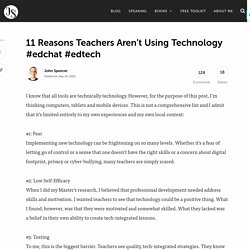
However, for the purpose of this post, I’m thinking computers, tablets and mobile devices. This is not a comprehensive list and I admit that it’s limited entirely to my own experiences and my own local context: #1: Fear Implementing new technology can be frightening on so many levels. Whether it’s a fear of letting go of control or a sense that one doesn’t have the right skills or a concern about digital footprint, privacy or cyber-bullying, many teachers are simply scared. #2: Low Self-Efficacy When I did my Master’s research, I believed that professional development needed address skills and motivation.
. #3: Testing To me, this is the biggest barrier. Welcome Back. Connectivism presentation. Welcome Back. A Brief Overview of 4 Learning Theories. Why Some Teachers Are Against Technology In Education. Why Some Teachers Are Against Technology In Education by Terry Heick Some educators are upset. Recently I’ve noticed an increasing number of ed folks enthusiastically question education technology—and do so with enough sarcasm and bitterness and choice language to embarrass their mothers. If you’re not making some people angry, you’re probably not trying hard enough, but being “for” or “against” technology is a crude sentiment. I’ve been trying to understand it–and note, this isn’t even about whether or not #edtech is good or bad.
This has a few net negative effects, among them a kind of permanent momentum where change comes and change goes. Failure is the change. Some observant educators have noticed this trend, and so preach patience and fidelity when integrating critically necessary new thinking—even when, like scripted curriculum or test-based accountability, that thinking is flawed. The Problem With The #edtech Conversation This is a big part of the problem. What factors support or prevent teachers from using ICT in their classrooms? Creative and active teaching and learning: Dr. John Zubizarreta at TEDxColumbiaSC. Redefining Learning & Teaching using Technology. Changing teaching and learning. Technology in Education - From Novelty to Norm. Teaching Methods for Inspiring the Students of the Future. Innovative Uses of Technology and Teaching Strategies.